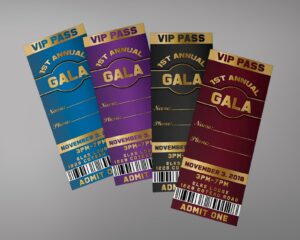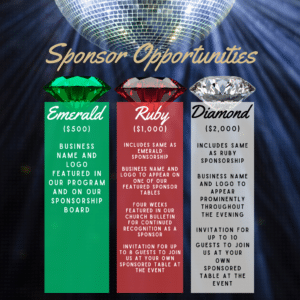The Secret Formula for a Successful Fundraising Event
You have a fundraising event and are in charge of making it happen. Your team has decided on a fundraising goal, and you have weeks to build a fundraising program to make it happen. Yikes!
Of course, if you have a mature event that you have hosted previously, you have a fairly good feel for the potential to achieve your fundraising goal based on the event’s history. There is more uncertainty about where funds will come from for newer fundraising events. In both scenarios, it helps to have a fundraising plan of action that helps you project where the funds will come from to achieve your goals. Rather than hope and expect an outcome, planning will give you a leg up on your fundraising and reduce the stress and anxiety over your event!
At Mission First Fundraising, we have provided a tool to build your fundraising plan for the event. You can input all of your fundraising elements into this tool and create a fundraising plan of action toward achieving your goal. Here is how to use this site effectively, with some tips for using the tool to its fullest capacity.
Sign up!
First things first, as you enter the site, you will see 100+ travel and experience packages that can be used to augment your fundraising. Many of you are looking for exciting trips for your live auction, using consignment items, or need a trip as a raffle item and even in the silent auction. The list of packages on this site is called a “best of” list of auction items, which means they have been vetted for you based on the best value, customer service, and return on investment. The packages on this website have shown an average of 200% ROI across over 1,000 fundraising events, which is an acceptable return on investment and worthy of consideration.
That said, you can use this tool without using any consignment items. It is up to you to decide how to achieve your fundraising goal, and if needed, consignments can help you get there! The sign-up process is simple: adding your name, email address, name of charity, and name of event, along with a few other data points. If you have a professional auctioneer for your event, you can add them to the signup, allowing them to collaborate with you directly on the site later.
Once you have signed up, you can return as often as you like to review previous planning and modeling and continue to tweak as you progress toward your fundraising goals.
Select at Least One Consignment Item
To use the fundraising plan of the auction, you must choose at least one consignment item for now. You can later decide whether or not you want to use consignment, but this allows you entry into the platform to utilize its full potential.
You will notice at the bottom right a button to click called “View your Event Portfolio.” This is where you will see your full fundraising plan of action and will spend time building out your projections modeling to your fundraising goal.
We will discuss the typical fundraising program elements later in this post. For now, peruse the travel packages to see if some might fit your fundraising elements. Remember the donated items you already have, but seek to create a fully rounded live auction by selecting items from any of the 14 categories. You can use these selections as placeholders in your fundraising plan of action and then be more intentional in asking donors who might be able to fulfill these categories with their donations instead of consignment. For more information on designing a live auction, check out our blog post on the 7 Basic Rules of a Successful Live Auction. A typical live auction will be anywhere from 3-10 live auction items (schools typically have more) with variety to offer your bidders domestic travel, international travel, beach destinations, sports, golf packages, special events, etc. In a perfect world, you will have 6-8 auction items, with no more than 2-3 consignment items.
As you select items from the site, you will select where to put them in your fundraising program. There are several options, including live auction, silent auction, raffles, and others. The live auction is the most obvious placement for consignment because you can sell multiples to competitive bidders when you have achieved the appropriate ROI.
Vacation Station
Another successful strategy for using consignment is to add a Vacation Station to your silent auction. A Vacation Station is a great way to augment your fundraising results by offering 6-10 travel options not included in the live auction. You may struggle with deciding which trip to put in the live auction. In this case, add those not making the live auction list to your Vacation Station. Please note it is typical that items on your silent auctions do not perform as well as in live auctions in terms of ROI, so it is recommended to put your Vacation Station items in a “buy it now” mode. Set your “buy it now” price at 50% above the cost of the item, so if an item costs $1,000, you can set your “buy it now” price at $1,500. Some of you will use higher or lower “buy it now” price points based on attendees, but this is a good benchmark to start from.
Once you have selected which part of the fundraising program the trips should be added, hit “Add to your Event Portfolio.” It is as simple as that!
View Your Event Portfolio
At any time, you can go directly to your Event Portfolio, which will present your fundraising elements, including a paddle raise section. Since no items are involved in a paddle raise, this section will be filled out separately, which we will discuss later in this post.
It is important to note that you can skip any of these sections, bypass creating your fundraising plan, and simply hit the reserve button at the bottom. The fundraising plan of action tool is there for your convenience and to assist you with modeling your results for the event. As you model this, you can download the projections based on your input and share them with your team or board so they know where the funds will come from. This tool empowers you to provide information for decision-making, helps validate your plan of action, and will help you achieve your goals.
You will see the consignment items you selected in each category (Live, Raffles, Silent), and it will display your cost, an estimated sell price (Strike Price), and your net proceeds. Please note that these sell price and net proceeds estimates are purposely conservative, as some of you will have access to a professional auctioneer who can achieve higher results than an amateur. We expect you to perform above these estimates with the right professionals supporting you!
Notice the “Add Manual” below each section. This is where you can add any and all of your donated items to the fundraising plan of action. You will enter your preferred name for the item (we recommend you include the word DONATED), then manually enter if there is any cost associated with the donated item, what you think it might sell for at your event, and if there is the opportunity to sell more than one. If you feel confident these items will sell more than once, proceed to enter a projected quantity that will be sold. This same option is there for the consignment items, so if a particular trip you feel will have mass appeal, you can enter a higher quantity for modeling purposes. If you have a professional auctioneer at your disposal, they can guide you on how many will sell based on your audience’s demographics. Of course, your event’s past results can also be a predictor, so use this tool as a collaboration tool to model and build your fundraising plan.
The “Add Manual” button is available for each section of this tool. For “Revenue Enhancers,” you can add other raffles that may not be prize-related, such as heads and tails, a 50/50 raffle, or a wine pull. The idea here is to enter any of your fundraising elements into this tool to model results. For example, if you believe 100 donors will participate in the wine pull for $50 each, then enter that projection into the tool.
Ticket Sales

You can also use the Revenue Enhancers section to model other aspects of your fundraising plan. For example, select “Add Manual” and enter the term “Ticket Sales,” then enter the number of tickets you expect to sell to attend your event and the ticket price. For different tiers of ticket sales, you can enter additional manual items into the tool.
Sponsorships

You can also add sponsorships in the “Revenue Enhancers” section. Simply select “Add Manual” and enter the term “Gold Sponsor,” then enter how many Gold Sponsors you expect to achieve and how much the sponsorship amount will be. You can add each sponsorship level in this manner to see all fundraising elements in this fundraising plan of action!
Paddle Raise
Whether you call it Fund-a-Need, Fund-a-Cause, Scholarship Auction, Mission Moment, or some other version, the Paddle Raise is typically the biggest fundraising element the night of your event. You will enter the number of guests expected to attend and your overall fundraising goal. Notice at the top of this section, you can also input pre-committed or matching funds, which should be factored into your goal achievement. Once you have input these figures, then you will add your paddle raise levels from highest to lowest levels. The tool will calculate how many people typically give at each level. You have the option to manually update the quantity of givers at each level based on history or other known donor demographics. This allows you to model paddle raise scenarios based on your fundraising goal and the ability to achieve that goal.
Summary of Fundraising
After all of these fundraising elements have been added and modeled, you will see at the bottom if you are close to reaching your goal. You will likely model this plan several times to get to the goal you had planned for. You will want to save your edits each time before you exit the site, but when you return, these saved edits will be there for you to continue modeling.
You will likely want to discuss this plan of action with everyone who is an active participant in the fundraising plan, which includes your board, your staff, your auctioneer, and maybe even key supporters who have a vested interest in the success of your event. This tool provides you with a security blanket for how you will be able to achieve your fundraising goal. If the goal is realistic compared to your potential fundraising elements, then you are going to have a successful night! If not, you may need to go back to the drawing board and find additional ways to enhance your fundraising plan of action.
Reserve any Consignments
A couple of weeks before your event, you will want to finalize the use of any consignment items and “Reserve” these for your event. This provides price protection and availability of each consignment item for your event. By reserving the items, you will also receive collateral to use for promotion of the item on social media, at your event, and winner notification collateral. You will also receive access to additional photos and videos as you get your audience excited about your live auction, etc.
After Your Event
This tool continues to support you after your event is over. You will want to return to this site to update your actual results. The tool can also be used as a debrief document you can share with your board and team and save for next year’s gala lead to use as a reference. We have added an open section at the bottom for you to input specific feedback on your event, such as any potential challenges the night of (e.g., sound, lighting, slow catering), as well as successes of the night (e.g., on-time run-of-show, stronger than expected raffle sales). This summary is helpful for you to express your observations about the event for further analysis.
As you update the quantity of items sold for both consignment and donated items, the tool will open a row below to enter winner information. This information is optional for donated items in case you want everything in one place, but necessary for consignment items so that we can contact all of your winners with further details on their trip and what to do next. The sooner you enter this information, the sooner your winners can be contacted about what they won.
Final Thoughts
This tool will help you from the time you start planning your event to the post-event steps to take care of all of your winners. You will increase your confidence in your fundraising plan of action and allow for input from others to ensure the fundraising plan of action will meet your goals. You will also have a record of results and observations that can be reviewed for your next event lead, taking key learnings and continuing to build on them for continued success. This tool is optional of course, but we think you will love having a tool like this to model your fundraising plan of action for any and all future events!
We wish you the best of luck with your upcoming fundraising events!
FAQs
How do I start using the fundraising planning tool for my event?
You start by signing up on the Mission First Fundraising platform. Once registered, you can select consignment items, build your fundraising plan, and model projections to help achieve your fundraising goals.
What are consignment items, and how can they help with fundraising?
Consignment items are travel and experience packages that can be added to your live or silent auction. They offer a great return on investment by attracting high bids and can help you achieve your fundraising goals when incorporated strategically.
How should I price Vacation Station items in a silent auction?
For Vacation Station items, it is recommended to set a “buy it now” price at 50% above the cost of the item. For example, if the item costs $1,000, you would set the price at $1,500 to maximize your fundraising results.
What is a paddle raise, and why is it important for fundraising events?
A paddle raise, also known as Fund-a-Need or Mission Moment, is typically the largest fundraising element of the night. Guests pledge donations at various levels, helping to achieve your overall fundraising goal.
How can I use the fundraising tool to model different revenue enhancers like raffles or ticket sales?
You can add manual entries for elements such as raffles, ticket sales, and sponsorships in the Revenue Enhancers section. This allows you to model and project your fundraising income from multiple sources.
What should I do after my fundraising event with the results?
After your event, return to the platform to update actual results and enter winner information for consignment items. You can also document observations, challenges, and successes to help plan future events.






